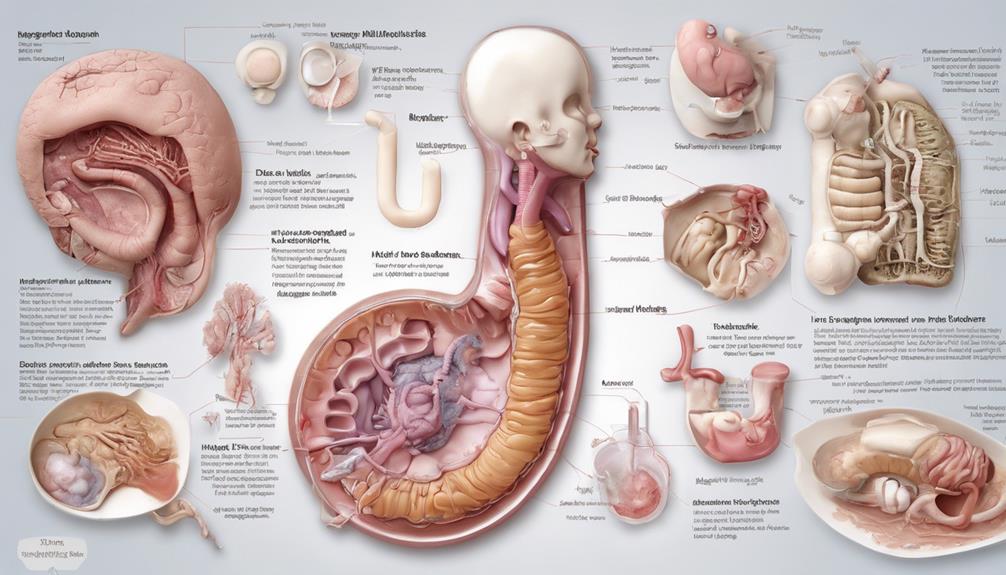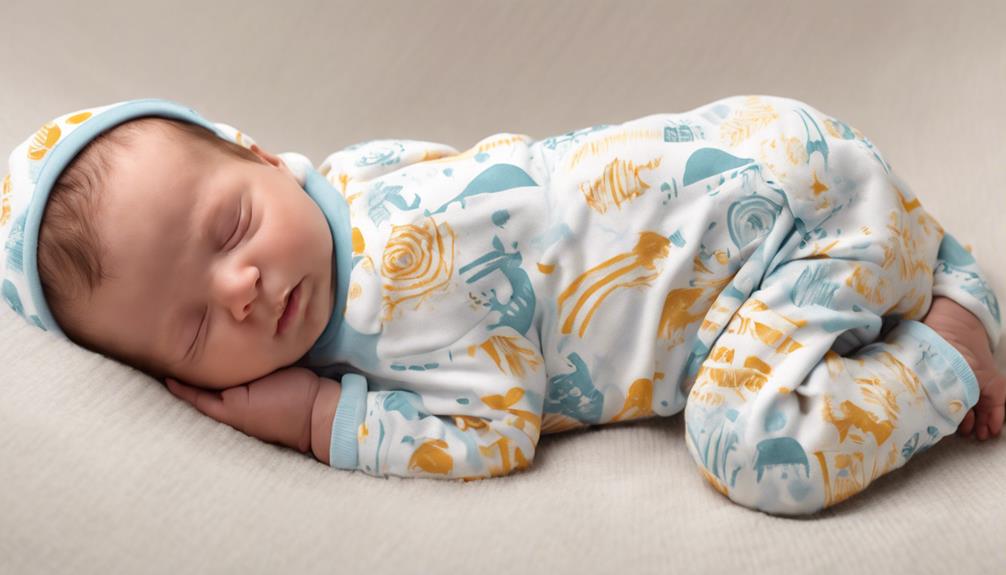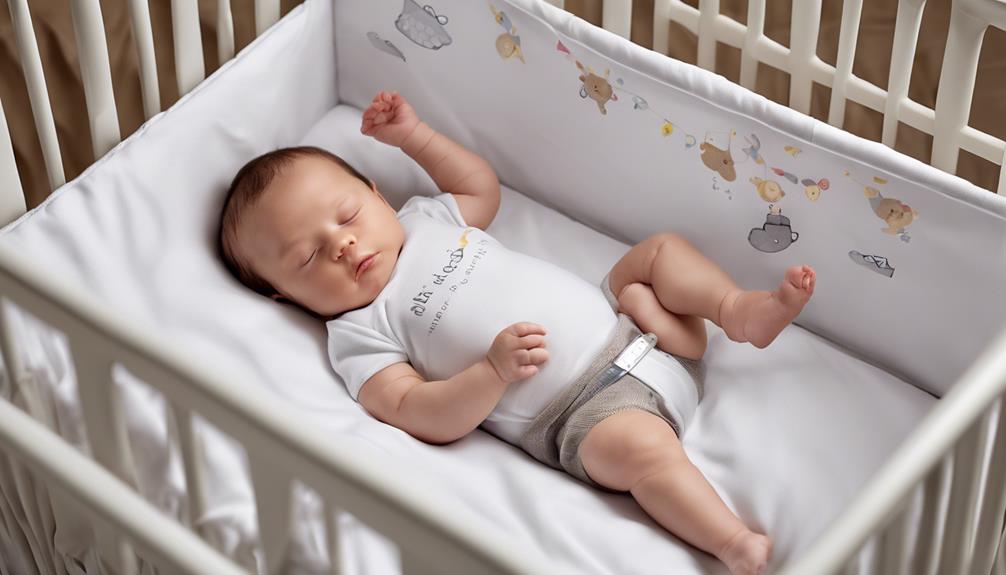As new parents, we all know the struggle of trying to get our newborn to sleep soundly in the crib. It can feel like an endless cycle of soothing and settling, with sleep seeming elusive.
However, there are proven strategies that can help ease this process and promote better sleep for both your baby and yourself. Let's explore some practical tips and techniques that can make a significant difference in establishing a peaceful bedtime routine and ensuring your little one gets the rest they need.
Key Takeaways
- Establish a peaceful bedtime routine with calming activities for crib sleep.
- Understand newborn sleep patterns and variations to adjust expectations.
- Transition early to the crib and create a safe, cozy sleep environment.
- Troubleshoot common sleep challenges with expert guidance for successful crib sleep.
Establishing a Peaceful Bedtime Routine
To create a soothing bedtime routine for your newborn, we recommend incorporating calming activities that signal it's time to sleep. A consistent routine can help your baby understand when it's time to wind down and get ready for sleep. Activities like giving your baby a warm bath, a gentle massage, or reading a bedtime story can create a peaceful environment that eases your little one into sleep mode. Dimming the lights during the bedtime routine can also help set the stage for relaxation and promote a sense of calmness.
Emphasizing safe sleep practices within the bedtime routine to make sure your baby feels secure in the crib. By helping your baby form positive associations with the crib during this routine, you can encourage smoother and more peaceful sleep changes. Remember, newborns thrive on routine, so consistency is crucial to helping your baby feel comfortable and relaxed when it's time to drift off to dreamland.
Understanding Newborn Sleep Patterns

How do newborns typically experience their sleep patterns during the first few months of life? Understanding newborn sleep patterns is important for creating a healthy sleep environment for your little one. Here are some key points to keep in mind:
- Newborns have fragmented sleep cycles with frequent awakenings, usually sleeping 14-17 hours a day.
- Babies' sleep patterns vary widely, especially in the first four months, with some sleeping more or less than expected based on age.
- Healthy children may have different sleep needs, so consulting a pediatrician if the baby's sleep deviates significantly from the norm is recommended.
- Establishing consistent sleep patterns in the crib may take time as babies adjust to their new environment.
Transitioning to the Crib Successfully

Moving your newborn to the crib successfully involves creating a safe and cozy sleep environment that promotes healthy sleep habits right from the start. Shifting your newborn to the crib can begin early, establishing a secure environment for rest.
It's beneficial for newborns to sleep in the crib from day one, fostering positive sleep associations. Lowering the mattress height as your baby grows guarantees safety and prevents climbing hazards. Encouraging playtime in the crib helps with the adjustment process, making the crib a familiar and comfortable space for sleep.
Following safe sleep practices, such as using a firm mattress and avoiding loose bedding, maintains a secure sleep environment for your newborn. By gradually acclimating your baby to the crib and adhering to safety guidelines, you set the stage for healthy sleep habits and a peaceful sleeping routine for both you and your little one.
Troubleshooting Common Sleep Challenges

When facing common sleep challenges with your newborn, it's important to address issues like colic, reflux, and disruptions in sleep patterns promptly and with patience. Here are some tips to troubleshoot these common challenges:
- Consult with Pediatricians: Seek guidance from healthcare professionals like pediatricians or lactation consultants for persistent sleep issues. They can provide valuable insights and recommendations tailored to your baby's specific needs.
- Adapt to Evolving Sleep Patterns: Be patient as newborn sleep patterns evolve and adapt to changing needs. What works one week may not work the next, so stay flexible and adjust your routines accordingly.
- Create a Calming Sleep Environment: Adjust daytime routines and create a calming sleep environment to promote crib sleep. Dim the lights, play soothing sounds, and establish a bedtime routine to signal to your baby that it's time to sleep.
- Prioritize Safe Sleep Practices: Always prioritize safe sleep practices and monitor your newborn for signs of discomfort that may be affecting their sleep. Ensure the crib is free of hazards and follow recommended guidelines to reduce the risk of Sudden Infant Death Syndrome (SIDS).
Ensuring Safe Sleep Environment

Addressing common sleep challenges with your newborn is important, and creating a safe sleep environment is paramount for ensuring your baby's well-being and restful sleep. To achieve this, opt for a firm crib mattress with snug fitted sheets to reduce the risk of suffocation. Keep the crib free from blankets, pillows, and stuffed animals to prevent potential hazards during sleep.
It's essential to maintain a comfortable room temperature and dress your newborn in light sleep clothing to avoid overheating. Following safe sleeping guidelines, such as room-sharing with your baby, can reduce the risk of SIDS by up to 50%. By implementing these measures, you not only provide a secure sleep environment akin to a bassinet but also foster a safer sleeping space that prioritizes your little one's safety and comfort.
Frequently Asked Questions
How Do I Get My Newborn to Stay Asleep in His Crib?
We've found that gently comforting and providing a calming environment for our newborn before placing them in the crib drowsy but awake helps them learn to settle themselves to sleep. Consistency and patience are key.
Why Does My Newborn Wake up When I Put Him in the Crib?
When we put a newborn in the crib, they may wake due to separation anxiety, teething discomfort, or changes in sleep environment. Some babies startle from the stillness after being rocked. Adjusting to the new space takes time.
How Can I Make My Newborn Crib More Comfortable?
We aim to enhance our newborn's crib comfort by ensuring proper mattress fit, using breathable bedding, maintaining a cozy room temperature, and creating a calming environment with white noise or lullabies. These steps can promote peaceful sleep for our little one.
Why Is My Baby Having a Hard Time Sleeping in the Crib?
We comprehend the frustration when babies struggle with crib sleep. Factors like teething or reflux can disrupt their rest. Consulting a doctor and a gradual crib change can help. Patience and consistency are key.
Conclusion
As we navigate the joys and challenges of parenthood, creating a peaceful sleep environment for our newborns is key. By understanding their unique sleep patterns and implementing a consistent bedtime routine, we can help them settle into the crib with ease.
Remember, safety is paramount, so guarantee the crib is free of hazards. With patience and love, we can support our little ones in getting the rest they need to thrive.
Sweet dreams to all!









